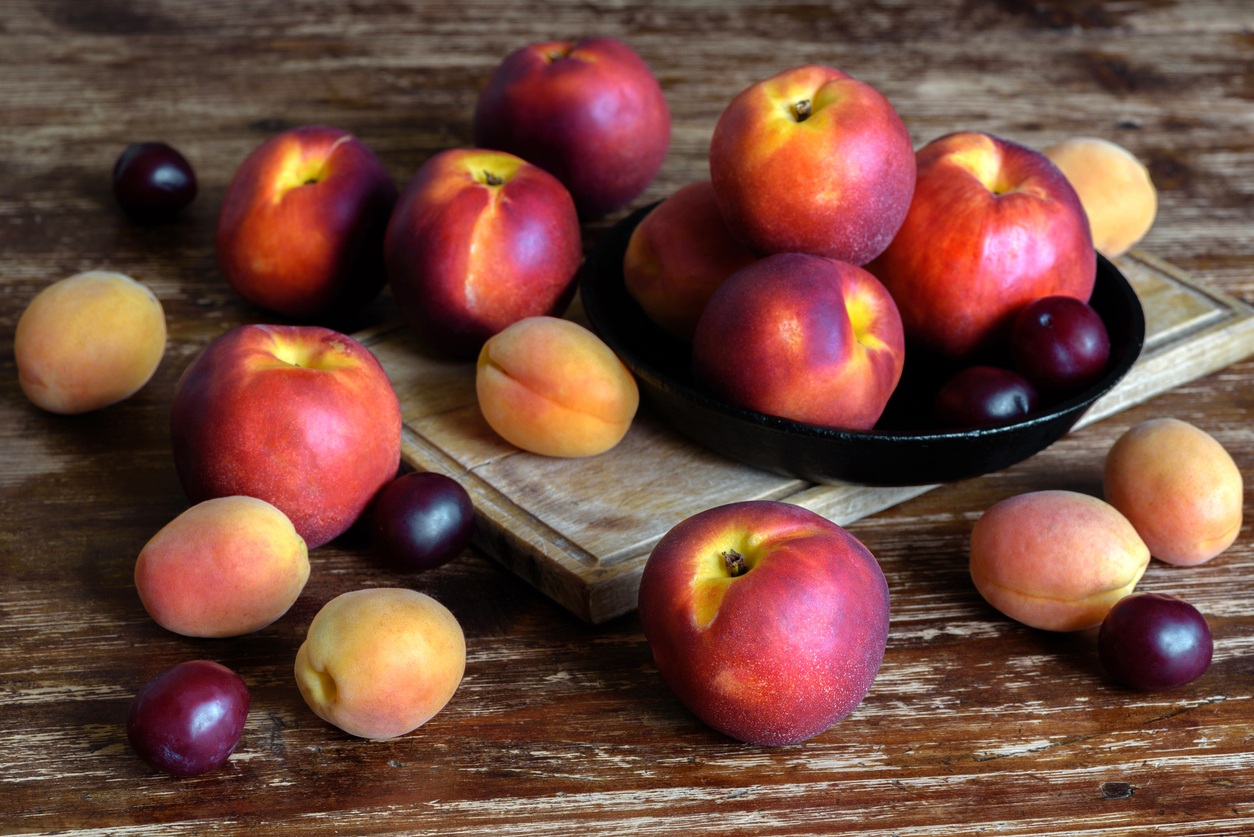Ah, summertime. Hot weather, cool beaches, and all the delicious stone fruit you can eat! Summer is the time of year when we finally get to welcome in these beauties at Oliver’s – whether it’s plums or cherries, peaches or nectarines, stone fruit is truly a staple of the season.
Now, let’s break down what we actually mean by “stone” fruit. Stone fruit, also known as drupes, have pits (hint hint, that’s the stone) surrounded by soft fruit and encased in a thin skin that is sometimes inedible. Stone fruit are like delicious little health grenades, packed to the gills with vitamins and fiber, and the calories typically range from only 40 to 90 calories per serving, depending on the type of fruit. This makes stone fruit a fantastic alternative to sugary treats or starchy snacks; however, you want to make sure you’re eating fresh stone fruit. While stone fruit may be available in cans or jars year-round, they’re typically packed in thick syrup that loads the fruit with added sugar, completely negating the potential health benefits. Ergo, get them while the getting’s good! In California, stone fruit season usually lasts from early June to mid-September, giving you plenty of time to load up on the fresh stuff.
Now, stone fruit have – completely unjustly – earned a reputation for being difficult to pick. Everyone knows the routine: you go to the store, eager for some tart cherries or a juicy peach, and are immediately faced with a veritable plethora of fruit. Suddenly, you’re forced to narrow down that bounty to the best possible fruit you can pick at that moment precisely. You don’t want them to bruise, but you don’t want them to be rock hard for days either, and they still have to be sweet and juicy at the same time! It’s a lot. Never fear – we’ve got the tips and tricks to have you picking peaches or plums like a pro in no time!
The Nose Knows
A really easy way to tell if you’ve got a sweet peach or nectarine is by the smell. Sniff right where the stem would connect – if you’ve got a good one, it should smell sweet and fragrant but not malty or fermented. Picking plums is a little trickier, as they range from very tart to lovely and sweet, and there are a huge variety of different plums to choose from. If you’re unfamiliar with the variety, ask your grocer if you can try a plum first; once you’ve found a flavor profile you like, get nosy!
Get A Feel For It
Surprisingly, despite being notoriously easy to bruise, you don’t really want to pick super hard pieces of fruit. Instead, look for fruit that has a very slight give to it when you squeeze it. You want to avoid fruit that’s super ripe unless you’re planning on eating immediately, and even then, really ripe fruit tends to be fairly messy, so be warned. If there’s only hard fruit available, keep them in a closed paper bag for a few days – the fruit will continue to ripen, and after sitting for a bit, will be perfect for eating. You also want to look for fruit that is particularly heavy for its size. The heavier the fruit, the juicier it will be!
Live Colorfully
Vibrant, saturated colors are key to picking good stone fruit. For peaches and nectarines, look for fruit that has no green or wrinkly patches; look for bright, saturated colors, and with nectarines specifically, look for an orange or gold cast to the skin. For cherries, the stems should be fresh and green, while the fruit itself should have a deep color and be free of pitting in their skin. Plums are really going to be dependent on the variety, but you can use the skin color as a kind of unreliable cheat sheet – plums varieties with really deep, dark skin have a tendency to be sweeter that other varieties, but still see if you can taste the plums before you actually buy them. Apricots are actually better if they’re a little ugly. Ignore the blemishes, and look for apricots that are plump and orange in hue.
Once you get your stone fruit home, you’ll want to make sure you store them correctly as well – the last thing anyone wants is to reach for a perfect peach and instead find a goopy mess. If you’re planning on eating them right away or if they’re a little under-ripe, go ahead and leave them on the counter, stem side down. They will continue to ripen as they sit, so keep an eye on them; if they seem to be getting too ripe or if they’re right at the stage where you want to eat them, pop them in the refrigerator to squeeze out an extra couple of days.
No matter what stone fruit you’re craving, stop into Oliver’s this week for great deals on these juicy gems of Summer! Check out delicious stone fruit like fresh peaches and succulent nectarines from Nick Boldt, which are certified organic for the first time this year! Click HERE to see more of what we have in store, or stop by your local Oliver’s to browse our full, seasonal selection.


Comments
Add a comment[…] and just a slight amount of give when squeezed (check out our handy guide to picking stone fruit HERE). Technically, nectarines are actually just peaches that lack the gene for fuzzy skin; however, the […]
Pingback by Juicy Gems of Summer: Stone Fruit is Back! - Oliver's Markets on July 2, 2019 at 11:46 pm